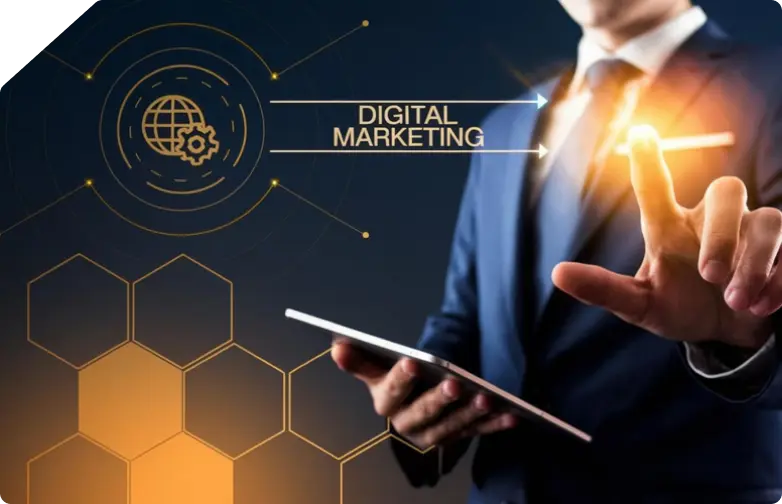In the age of rapid technological advancements, digital marketing has become a cornerstone of modern business strategies. It allows companies to connect with their target audiences, build brand awareness, and drive measurable results through data-driven approaches. This article explores the importance of digital marketing, its components, tools, and how it shapes the success of businesses in the digital age.
1. Introduction to Digital Marketing
Digital marketing involves promoting products or services through online channels like websites, social media, email, and search engines. Unlike traditional marketing, digital marketing enables businesses to interact directly with their audience and measure the impact of campaigns in real-time.
From small startups to multinational corporations, businesses of all sizes are leveraging digital marketing to create brand visibility and achieve their goals in an increasingly digital-first world.
2. Why Digital Marketing is Crucial for Modern Businesses
Enhanced Reach and Accessibility
With billions of people using the internet daily, digital marketing enables businesses to reach a global audience. Platforms like Google, Facebook, and Instagram make it possible to connect with customers anytime, anywhere.
Cost-Effective Marketing Solutions
Digital marketing is more affordable than traditional advertising channels like TV or print. Techniques such as email marketing, SEO, and social media campaigns allow businesses to achieve significant results without a massive budget.
Real-Time Interaction with Customers
Unlike traditional marketing, digital marketing enables real-time interaction. Whether through social media comments, live chats, or email responses, businesses can address customer queries instantly and build stronger relationships.
Data-Driven Decision Making
Digital marketing provides valuable insights through analytics tools like Google Analytics and HubSpot. Businesses can track metrics such as website traffic, conversion rates, and user behavior to refine their strategies and make informed decisions.
3. Key Components of Digital Marketing
Search Engine Optimization (SEO)
SEO involves optimizing your website to rank higher on search engine results pages (SERPs). Effective SEO drives organic traffic to your website by targeting relevant keywords and improving the user experience.
Pay-Per-Click Advertising (PPC)
PPC allows businesses to place ads on search engines or social media platforms and pay only when users click on them. Platforms like Google Ads and Facebook Ads help reach targeted audiences with measurable ROI.
Social Media Marketing (SMM)
Social media platforms like Instagram, LinkedIn, and Twitter are essential for brand building and engagement. SMM involves creating tailored content, running campaigns, and analyzing metrics to reach and interact with the audience effectively.
Content Marketing
Content marketing focuses on creating valuable, relevant, and consistent content to attract and retain a defined audience. Blogs, videos, infographics, and eBooks are examples of content marketing assets that boost brand authority and drive engagement.
Email Marketing
Email marketing remains one of the most effective tools for nurturing leads and retaining customers. Personalized email campaigns can drive conversions and keep customers informed about products, services, and promotions.
Affiliate Marketing
Affiliate marketing involves partnering with affiliates who promote your products or services for a commission. It’s a cost-effective way to reach a larger audience and boost sales.
4. Tools Used in Digital Marketing
Google Analytics
This tool helps track website performance, user behavior, and traffic sources. It provides valuable insights to improve digital strategies.
Hootsuite
Hootsuite allows businesses to manage multiple social media accounts, schedule posts, and analyze campaign performance.
SEMRush
SEMRush is a comprehensive SEO tool for keyword research, site audits, and competitor analysis, helping businesses improve their search rankings.
Canva
Canva simplifies the process of creating visually appealing graphics for social media, blogs, and email campaigns, even for non-designers.
Mailchimp
Mailchimp is a popular email marketing tool that allows businesses to create, send, and track email campaigns effectively.
5. The Impact of Digital Marketing on Consumer Behavior
Digital marketing has significantly changed how consumers interact with brands. Customers now research products online, read reviews, and compare options before making a purchase. Social media platforms have also created a space for peer recommendations and user-generated content, influencing buying decisions.
Businesses that invest in personalized marketing and engage meaningfully with their audience are more likely to win customer trust and loyalty.
6. Challenges in Digital Marketing and How to Overcome Them
Challenge 1: Increased Competition
With so many businesses using digital marketing, standing out can be difficult.
Solution: Focus on unique value propositions and invest in creative content strategies.
Challenge 2: Ad Fatigue
Customers often feel overwhelmed by ads, leading to ad fatigue.
Solution: Create non-intrusive, high-quality content that adds value instead of relying solely on advertisements.
Challenge 3: Rapid Technological Changes
Keeping up with ever-evolving digital marketing tools and trends can be challenging.
Solution: Stay updated by attending webinars, reading industry blogs, and enrolling in digital marketing courses.
7. Future Trends in Digital Marketing
Voice Search Optimization
With the rise of voice assistants like Alexa and Siri, optimizing content for voice search is becoming crucial.
Artificial Intelligence and Machine Learning
AI is transforming how businesses analyze data, personalize customer experiences, and predict consumer behavior.
Interactive and Video Content
Interactive content like quizzes and video marketing is gaining popularity for its ability to engage users more effectively.
Augmented Reality (AR) and Virtual Reality (VR)
AR and VR are being integrated into digital marketing campaigns to create immersive experiences for customers.
8. Conclusion
Digital marketing is an indispensable tool for modern businesses. It enables companies to connect with their audiences, build strong relationships, and achieve measurable results. By leveraging tools, staying updated on trends, and addressing challenges effectively, businesses can harness the full potential of digital marketing to thrive in a competitive landscape.
Whether you’re a startup or an established brand, embracing digital marketing is no longer optional—it’s a necessity for success in today’s digital-first world.






